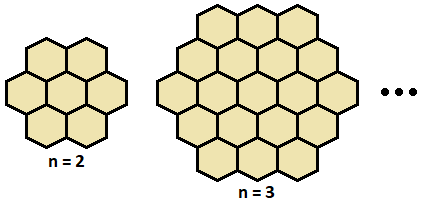Magic Hexagon Starting With 0
Which of the following hexagons with cells on each edge can be filled with consecutive integers starting with (not starting with ) in such a way that the numbers in each row (in all three directions) add up to a magic constant ?

This section requires Javascript.
You are seeing this because something didn't load right. We suggest you, (a) try
refreshing the page, (b) enabling javascript if it is disabled on your browser and,
finally, (c)
loading the
non-javascript version of this page
. We're sorry about the hassle.
The number of hexagons in a grid of side n is 3 n ( n − 1 ) + 1 , so the sum of numbers from 0 to 3 n ( n − 1 ) is 2 3 n ( n − 1 ) ( 3 n 2 − 3 n + 1 ) , and so the magic number should be 2 ( 2 n − 1 ) 3 n ( n − 1 ) ( 3 n 2 − 3 n + 1 ) = 3 2 ( 2 n − 1 ) 3 [ ( 2 n − 1 ) 2 − 1 ] ( 3 ( 2 n − 1 ) 2 + 1 ] Since 2 n − 1 and [ ( 2 n − 1 ) 2 − 1 ] [ 3 ( 2 n − 1 ) 2 + 1 ] are coprime, we see that M is an integer only when 2 n − 1 divides 3 , so when n = 2 .
If n = 2 then since neighbouring edge hexagons sum to the magic number M = 7 , any two non-consecutive edge hexagons must be equal to each other. Thus the seven hexagons cannot be filled with seven distinct numbers, so the case n = 2 is not possible, either.
There is no value of n ≥ 2 for which a 0 -based magic hexagon is possible.